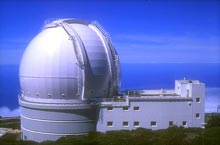Cannibalistic Stars hold clue to Big Bang

William Herschel Telescope <br>© PPARC
A team of UK astronomers announced this month the discovery of cannibalistic stars that explain one of the mysteries surrounding the Big Bang. The stars are almost as old as the Universe and they reveal what space was like in the very beginning.
The team from the Open University found that a group of 14-billion-year-old stars were all in a spin (literally) because of a nasty phase earlier in their lives. They were, in short, cannibalistic stars. The scientists` discovery not only explains the origin of these mysterious stars, but also strengthens the Big Bang theory. The Big Bang is the name given to the rapid expansion of the Universe that marked the beginning of space and time; it explains the origin of the matter in the universe – including the matter which people are made of.
The stars under investigation are some of the oldest in the Universe. They formed out of gas clouds not long after the Big Bang. The OU team, led by Dr Sean Ryan, found that some of the stars that formed early in the life of the Universe were very unusual. They contained none of the metal lithium which astronomers believe is produced in the Big Bang.
Dr Ryan said: “Observations showed that about 1 star in 20 contained no lithium, and some astronomers were concerned that this might mean we had misunderstood something important about the Big Bang and the origin of the Universe.”
New and more detailed observations of the peculiar stars were made with the 4.2-metre-diameter William Herschel Telescope. Using high precision equipment, the team found that most of the stars without lithium were spinning very fast. “Measuring the spin speed of stars is very difficult,” said Dr Ryan, “this is why no-one had seen this before. Most 14-billion-year-old stars do not spin very fast at all but these ones had up to 16 times as much spin energy as the Sun, our nearest star. We knew that the extra energy could come from only one source; another star.”
Dr Ulrich Kolb, an OU astronomer who specialises in interacting stars, explained what happened. “When these stars formed out of the gas clouds, not just one but two stars formed very near one another. Fatally, they were too close together for their own good. As they grew older, the smaller one captured the outer layers of the larger one. Very little now remains of what was the larger star; it has been cannibalised by its companion.”
The material captured by the companion carried orbital energy that was converted into spin energy. It was the discovery of the excessive spin energy that revealed the history of the objects. The scientists believe that the lithium was destroyed in nuclear reactions shortly before the star-eating episode occurred.
Dr Ryan said: “It`s rather a relief that we have discovered why the lithium-depleted stars are so different to most others. Knowing that the Big Bang theory tells us correctly how much lithium was produced gives us confidence that we really do understand much about the origin of the entire universe. Hydrogen that was formed in the Big Bang powers the Sun, which in turn provides energy to the Earth. It is also a vital component of pure water, which is so essential to life. Also we now know more about what happens when stars feed on one another.”
Using a technique called Doppler spectroscopy, the observations were made by measuring the speeds at which the stars are moving. This is similar to the way traffic speeds are measured on roads, but with stars clocking up many kilometres per second, not just a few kilometres per hour. The William Herschel Telescope on which the observations were made is one of the UK`s major telescopes. It is co-funded and operated by the Particle Physics and Astronomy Council (PPARC). It is located under the clear skies of the Canary Islands, where observing conditions are much better than in Great Britain. The telescope is shared with Dutch and Spanish astronomers. Dr Sean Ryan will be observing from the Canary Islands on 22-24 May.
The team`s work is described fully in a scientific report appearing in Astrophysical Journal on May 20.
Media Contact
More Information:
http://www.pparc.ac.ukAll latest news from the category: Physics and Astronomy
This area deals with the fundamental laws and building blocks of nature and how they interact, the properties and the behavior of matter, and research into space and time and their structures.
innovations-report provides in-depth reports and articles on subjects such as astrophysics, laser technologies, nuclear, quantum, particle and solid-state physics, nanotechnologies, planetary research and findings (Mars, Venus) and developments related to the Hubble Telescope.
Newest articles

NASA: Mystery of life’s handedness deepens
The mystery of why life uses molecules with specific orientations has deepened with a NASA-funded discovery that RNA — a key molecule thought to have potentially held the instructions for…

What are the effects of historic lithium mining on water quality?
Study reveals low levels of common contaminants but high levels of other elements in waters associated with an abandoned lithium mine. Lithium ore and mining waste from a historic lithium…

Quantum-inspired design boosts efficiency of heat-to-electricity conversion
Rice engineers take unconventional route to improving thermophotovoltaic systems. Researchers at Rice University have found a new way to improve a key element of thermophotovoltaic (TPV) systems, which convert heat…



